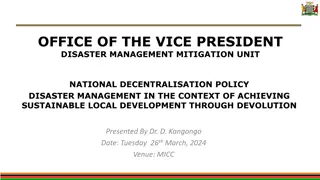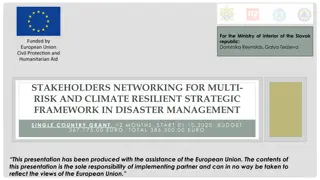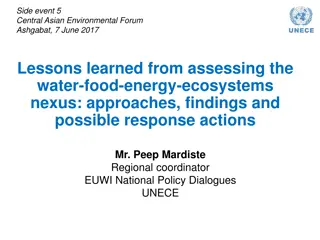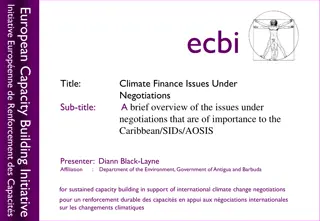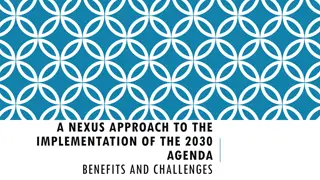Disaster Risk Management and Climate Change Nexus in Caribbean Region
The Caribbean region faces critical challenges due to the intersection of disaster risk management and climate change, with annual hydro-meteorological disasters on the rise. Countries like Haiti, Cuba, and Puerto Rico are experiencing increasing disaster impacts, urging immediate attention to climate-resilient coastal area development to mitigate projected sea-level rise and other climate impacts.
Download Presentation

Please find below an Image/Link to download the presentation.
The content on the website is provided AS IS for your information and personal use only. It may not be sold, licensed, or shared on other websites without obtaining consent from the author.If you encounter any issues during the download, it is possible that the publisher has removed the file from their server.
You are allowed to download the files provided on this website for personal or commercial use, subject to the condition that they are used lawfully. All files are the property of their respective owners.
The content on the website is provided AS IS for your information and personal use only. It may not be sold, licensed, or shared on other websites without obtaining consent from the author.
E N D
Presentation Transcript
THE DISASTER RISK MANAGEMENT - CLIMATE CHANGE ADAPTATION NEXUS Allan Lavell Regional Policy Dialogue on Disaster Risk Reduction Best Practices for Climate Resilient Coastal Area Development Bridgetown, Barbados October 20-21, 2011
Disaster and Climate Change: Critical Problems for the Caribbean Second most disaster prone region in the world Experiences $3 billion US Dollars in average annual disaster losses One of the zones most susceptible to projected sea level and other climate change impacts A good part of these effects will directly affect the highly critical coastal areas of the region
Annual number of hydro-meteorological disasters in the Caribbean region, 1960-2009
Annual number of hydro-meteorological disasters in the Caribbean region, 1960-2009 Rapid increase in small and medium sized storm and flood disasters which reflect skewed development practices Trend in storms is growing much faster than the trend in floods and landslides, which is the opposite of what occurs at the global , world level How to explain this discrepancy? heightened storm-generation pressures from climate change? large increases in exposure and vulnerability in the most susceptible regions? In either case, the trends are too alarming to be ignored especially with new climate change pressures.
Number of disasters per Caribbean country, by decade from 1960 to 2009, top 13 countries The countries represented on the left side of the graph have the total largest aggregate number of disasters ( Haiti, Cuba, Dominican Republic, Jamaica, and Puerto Rico) All of these larger island territories demonstrate rapidly increasing inter-decadal trends in terms of the sheer number of disasters
Annual population affected by disasters in the Caribbean region, 1960-2009
Annual population affected by disasters in the Caribbean region, 1960-2009 The number of people affected by storms is on the rise, and roughly similar numbers of homes are lost to both storms and floods The number of people affected by storms in the region (and in contrast to global averages) is an order of magnitude greater than the other sources of disaster affectation in the region. Figures for drought affectation have been of marginal significance in the past decade, although climate change models tend to indicate an increase in drought conditions in the area.
Annual number of homeless by hydro-meteorological disaster in the Caribbean, 1980-2009
Annual number of homeless by hydro-meteorological disaster in the Caribbean, 1980-2009 In the past 30 year period: one year (1980) has approached 1 million homeless (3% chance per year), five years have been in the neighborhood of 100,000 homeless (17%), ten years have had around 10,000 homeless (33%), and ten years have had around 1,000 homeless (33%) Between the two sources of hazard, storms and floods, there are only five years (17%) in which there were fewer than 100 homeless This underscores the regular nature of loss-generating events in the region, a pattern that typically leads to ongoing erosion of livelihood options, and thus greater vulnerability to the large events The regular occurrence (50%) of storms that trigger annual homeless counts between the 10,000 and 100,000 level is a clear indicator of the scale and frequency of typical intensive events in the region
Historic Impacts of Hydro-Meteorological Events in the Caribbean The Economic Commission for Latin America and the Caribbean (ECLAC) has calculated the following economic, social and environmental impacts from disasters (in terms of damage and losses) for the 1990-2008 period in the Caribbean sub-region: The total impact (in damage and losses) was estimated at US $ 136 billion The total economic impact was US$ 63 billion (46% of total impact), The social cost was US$ 57 billion (42% of total impact), The total infrastructural damage was approximately US$ 12 billion (9% of total impact) Damage to the environment was US$ 3.5 billion (3% of total impact).
Climate Change: Physical and Environmental Impacts: Sea Level Rise Sea level rise (SLR) of around 1.5 to 3 mm per year have been observed at tidal gauging stations around the Caribbean. (CARIBSAVE 2009, pg. 86). Even in the absence of increased intensity or frequency of tropical storms and hurricanes, SLR will intensify their impact on coastlines in the Caribbean. (UNDP 2010, p.74) A World Bank (2009) study on Sea Level Rise and Storm Surge in Jamaica concludes that there could be a 56.8% increase in affectation in the future, with 26.6% of the coastal population exposed and potential losses of coastal GDP projected to exceed 26.7%.
Physical and Environmental impacts: Coral Bleaching Physical impacts to the marine ecosystem also have knock-on economic impacts. If current trends in coral reef degradation continue, we can expect to see annual losses, by 2015: to fisheries in the $95-$140 million dollar range, to dive tourism in the $100-$300 million dollar range to shoreline services in the $140-$420 million dollar range
Economic Impacts The UNDP study on Quantification and Magnitude of Losses and Damages Resulting from the Impacts of Climate Change by Simpson et al concludes that: The Bahamas, Suriname, Guyana, Trinidad and Tobago and Belize are anticipated to suffer the greatest economic losses and damages in absolute economic terms. In terms of the economic costs associated with the effects of SLR, and in particular on the increased effect of extreme events due to SLR, the costs can be divided into capital outlays on new or improved coastal defenses and costs related to maintenance, repair and improvement of existing assets. For the improved defenses, construction costs are expected to be between $1.2 to $4.4 billion dollars, with ensuing annual maintenance costs somewhere above $100 million per year. Figure #11: Annual and Capital Costs of SLR in CARICOM Countries (in 2010 US $) (UNDP 2010, p.52)
Comments Regarding Impacts Considering a Caribbean population of approximately 36 million, historical trends in losses constitute an average of almost $4000 per capita over the 20-year period Despite the tremendous amount of work that has taken place in dealing with the social and physical-environmental impacts, it is still much more difficult to quantify the losses in these categories This difficulty of quantification translates into a lower degree of visibility of these problems amongst both policymakers and the general populace
Risk Management Index TTO = Trinidad & Tobago DOM = Dominican Republic JAM = Jamaica BBD = Barbados
Similarities and Synergies between DRM and CCA Response to non routine events, both extreme and non extreme, and the risk they imply Fundamental importance of affecting exposure and vulnerability to damaging events and dealing with similar root causes in skewed development Importance of local participatory approaches Need for corrective and prospective management.
Similarities and synergies between DRM and CCA Strategic approaches that DRM & CCA have in common: Environmental service management Land use planning and territorial organization Livelihood support Improved governance Structural and non structural instruments are similar
Differences between DRM and CCA DRM also deals with non hydrometeorological hazards Use of terminologies and understanding of concepts Importance of preparedness and response for DRM Institutional and financial mechanisms
DRM practice informed by CC Impacts Managing greater and different levels of uncertainty Managing greater levels of hazard stress Considering changing averages as disaster risk stressors Deal with new stresses associated with sea level rise and direct impact on land based activity
Important elements of practice We need to find approaches that go beyond existing sector, NGO, parish and other special interest group approaches to DRR in coastal areas. Projects and programs that promote greater interconnectivity, harmony, integration and comprehensiveness in actions over narrow-focus approaches structural approaches must be combined with soft approaches that seek to prevent the risk from being created altogether --- incorporate both corrective and prospective risk management techniques.






